From Dream to National Treasure: The Great American Rail-Trail
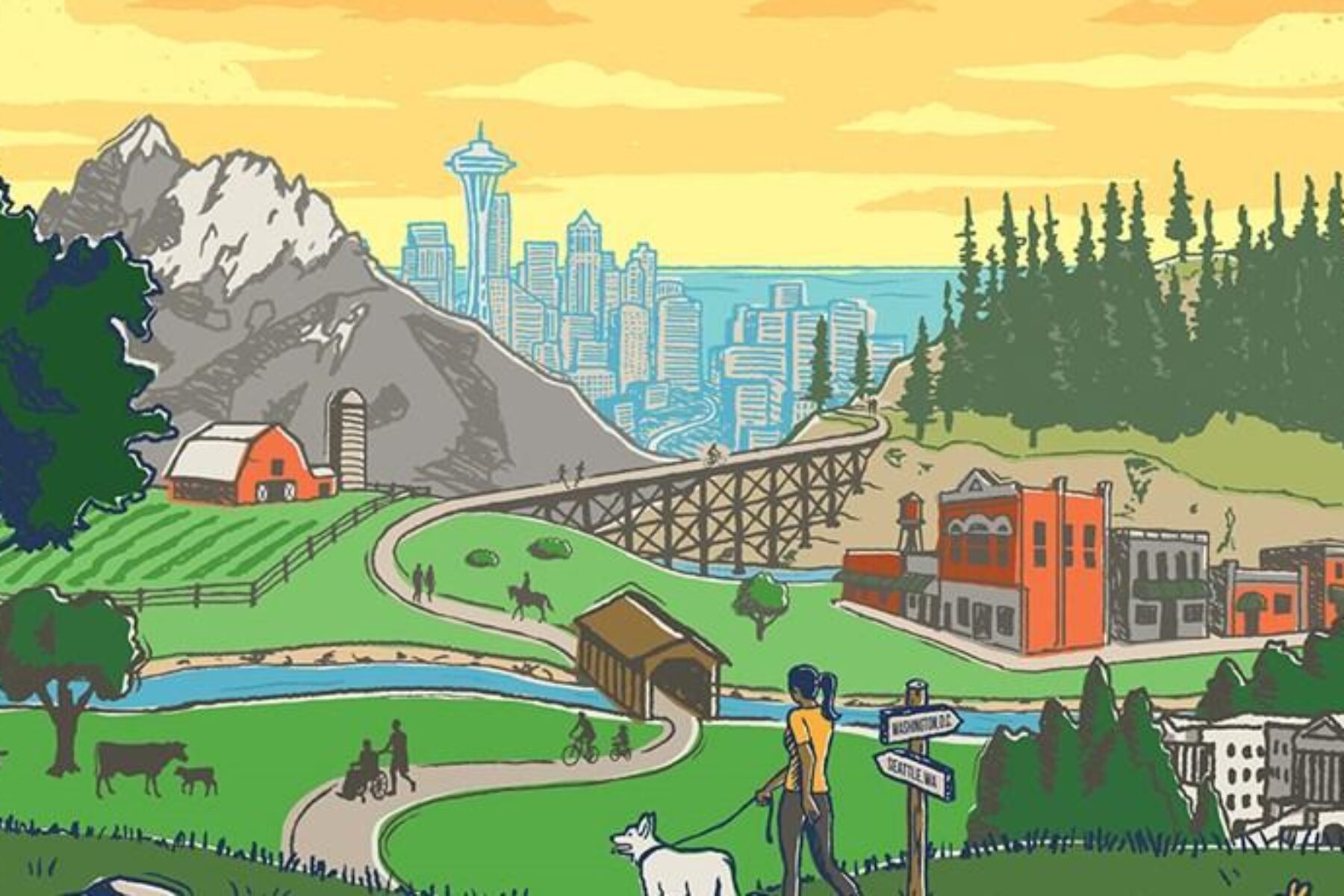
It was an idea that changed the world. The creation of Yellowstone National Park nearly 150 years ago established that a country’s iconic natural wonders could be preserved for all to enjoy. Today, a new bold vision again presents itself: The Great American Rail-Trail aims to create a multiuse path across the country, separated from roads for its entirety—a remarkable feat at more than 3,700 miles—and a lasting legacy for generations of Americans.
It’s fitting that in 2019 we celebrate the 150th anniversary of the Golden Spike, which marked the completion of the transcontinental railroad. Like that famed route, the expansive trail will chart a course to connect the country, spanning 12 states and the District of Columbia. This exceptional, uniquely American experience will directly serve approximately 50 million people within 50 miles of the route, as well as the millions of others from across the country and the world who will meet America’s diverse people and explore its diverse places via the trail.
Rails-to-Trails Conservancy (RTC) has been working closely with local trail partners, state agencies, elected officials and other interested groups to develop the preferred route of the Great American Rail-Trail, which will connect more than 125 existing trails—many of them built along former railroad corridors—between Washington, D.C., and Washington State. While the route is more than 52 percent complete today, RTC is providing the national vision, leadership and expertise to ensure connectivity across state lines and to bring the resources necessary to close approximately 1,700 miles of gaps in the trail.
Gateway Trails for the “Great American”

The Great American Rail-Trail includes 12 “gateway” trails—existing trails along the route that make possible this grand vision of a nation connected by trails. These gateway trails form the foundation for the “Great American” in each of the states it crosses. They have been built through the hard work and ingenuity of the trails community, who have rolled up their sleeves to protect and preserve these priceless corridors. Learn more about the gateways in our special extended Winter 2019 Rails to Trails “A View From … ” feature.
“Since the late 1980s, RTC has been tracking the possibility of a trail that connects the country. At one point, we had a map of the United States on the wall where we literally tracked every new rail-trail project with a pin and began to see a coast-to-coast rail-trail emerge before our eyes,” said Marianne Fowler, RTC’s senior strategist for policy advocacy, and an employee of RTC for more than 30 years.
She continued, “Then—and now—we were grateful for the incredible work of the trails community to preserve and build these trails that were beginning to form a line across America. The opportunity to complete the Great American Rail-Trail exists because of their enduring commitment to trails and, now, because of the power of the trails movement to get big things done.”
After analyzing the optimal route for the past two years, the vision for the trail was announced to the public in January 2019. “The amount of excitement out there has just been tremendous,” said Liz Thorstensen, RTC’s vice president of trail development, about the early feedback the organization has received since it began organizing collaborative planning meetings about the trail in 2017. “It speaks to people in lots of different ways, and at a time when people are looking for and craving more connections to each other and to the places they live.”
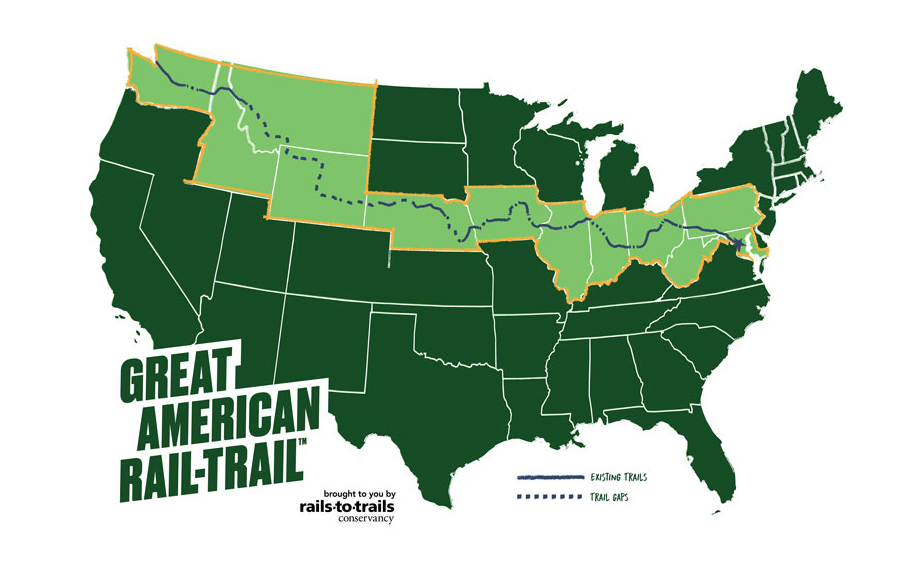
From the nation’s capital—just a stone’s throw away from the National Mall—the Great American Rail-Trail will head through Maryland, the Northern Panhandle of West Virginia and the southwest corner of Pennsylvania, continuing through the midwestern heartland of Ohio, Indiana and Illinois before reaching the Mississippi River. Across the majestic river and through central Iowa, the trail will travel westward as the pioneers once did, through Nebraska and Wyoming, where the route will pivot northward through the Rocky Mountain states of Montana and Idaho before traversing Washington on its way to Seattle’s Puget Sound.
All for One, and One for All
The dual nature of the Great American Rail-Trail experience will be one of diversity—in the settings, people and culture of the places it traverses—and unity, in that it is envisioned to be a safe, seamless and scenic pathway for all. “This trail is truly for everybody,” said Thorstensen. “The fact that it spans the country is bold. But the greatness of the trail is in the experiences we’ll all get from it, whether it’s taking a quick walk if you live close to it, or taking a day trip with your friends and family, or making the entire journey either in parts or all at one time.”
While walkers, hikers and bicyclists have been first to share their enthusiasm for the Great American Rail-Trail—and will likely make up the majority of the trail’s users—many sections will be open to varied nonmotorized uses, including horseback riding. In Washington, the Palouse to Cascades State Park Trail is one on which horses are not only welcome, but where horse culture is thriving. The cross-state trail was originally championed by the John Wayne Pioneer Wagons and Riders Association, a club that hosts an annual spring ride that draws participants from across the country to take a two-week journey on the trail by horse or wagon.
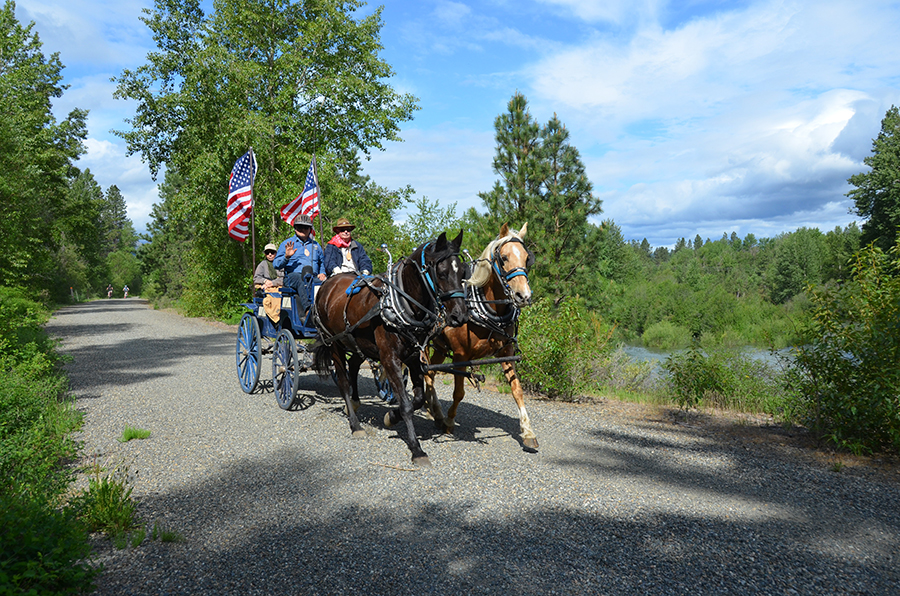
The group that spearheads it today, the Palouse to Cascades Trail Coalition, is working on a project to bring even more people together on the trail: the restoration of the Beverly Bridge. At its center, the Columbia River cleaves the trail in two with no safe way across, so the group’s top priority is opening up this historical railroad bridge over the river.
“Eastern Washington is very different from western Washington, not just geographically, but also politically, culturally and economically, so the bridge is kind of symbolic,” said Robert Yates, a board member of the trail’s coalition.
“The amount of excitement has been just tremendous.”
—Liz Thorstensen, Vice President of Trail Development, Rails-to-Trails Conservancy
“The Great American Rail-Trail will draw attention to sorely needed trail connections and improvements in every state it crosses,” said Kevin Mills, RTC’s vice president of policy. “RTC recognizes Beverly Bridge rehabilitation as a critical connection for Washington, so we are working with Governor Jay Inslee, the legislature and our partners in the state to prioritize funding to close this and other significant gaps in the trail.”
The bridge’s rehabilitation, which will connect eastern and western Washington, will enhance the trail’s role as a tourism draw for the entire state. “Geographically, the [Palouse to Cascades State Park Trail] has the best of what Washington has to offer,” affirmed Yates, who ticks off a series of scenic landscapes over the course of its 200+ miles, including mountain ranges, high desert, a river gorge and the gently rolling hills of the Palouse.
A Big Dream With Its Feet on the Trail

RTC’s goal is to create a national route using criteria that prioritize open trails and the user experience while bolstering state and local trail priorities. Therefore, it’s no surprise that the Great American Rail-Trail route connects several trail-rich states. But even states that did not have a large railroad infrastructure to build upon for their trail systems—like Wyoming, which has only 2 percent of the planned route completed in the state—have enthusiastically committed to the idea.
In early 2018, when momentum for the cross-country trail was just starting to build, Wyoming Gov. Matt Mead appointed a task force to develop recommendations for active transportation and recreation infrastructure investments. The group’s report encouraged the state to invest $10 million annually and includes the Great American Rail-Trail as a high-priority project to be supported by state agencies.
“One of the things that the report clearly detailed is the tremendous benefits that bicycling and walking trails bring,” said Tim Young, executive director for Wyoming Pathways, who served on the task force. “It’s the economic benefits—and it’s the quality-of-life enhancements in communities and their competitiveness in terms of attracting people, and the proven health benefits of active living. If you add those up, it’s a really good investment for the state.”

This auspicious pattern has been replayed in many of the states along the Great American Rail-Trail. The widespread enthusiasm for trails and excitement for the project’s bold vision are moving the dial from hopeful to happening.
Indiana is no stranger to dreaming big either when it comes to walking and bicycling projects. When the state created its first statewide trail plan in 2006, its goal was to have a trail within 7.5 miles of every Hoosier by 2016. Ten years later, as the state readied to revise its plan, they found that the goal was 98 percent achieved, so a new benchmark was set: to shorten the distance between trails and residents to just 5 miles. The original plan also established an interconnected web of arterial trails across Indiana.
“It’s the economic benefits … and it’s the quality-of-life enhancements. If you add those up, it’s a really good investment for the state.”
—Tim Young, Executive Director, Wyoming Pathways
“The route that the Great American Rail-Trail follows in Indiana is along this state visionary trail system, which has been a priority for us since 2006,” said Amy Marisavljevic, the trails section chief for the Indiana Department of Natural Resources. “It’s great that those mesh together really well.”
More than half of the Great American Rail-Trail through the state is already open, including Indiana’s longest rail-trail, the Cardinal Greenway, which entered RTC’s Rail-Trail Hall of Fame last year. With some recent good news, it’s anticipated that more Hoosier trails will come online.
“Back in September, Governor Eric Holcomb announced his Next Level Connections Program, which is a $1 billion infrastructure program, and that included $90 million to develop trails throughout Indiana,” enthused Marisavljevic. “We have seen throughout so many of our communities here in Indiana that they all really want trails.”
Where There’s a Will, There’s a Trail

Nestled within the Great American Rail-Trail in Ohio is a developing 326-mile route crossing the state from the shores of one of the country’s Great Lakes to the Ohio River. The Ohio to Erie Trail is a must-see destination connecting Cleveland, Columbus and Cincinnati, as well as some of the state’s unique natural and cultural treasures.
Communities along this route, which was conceived of more than 25 years ago, have been enjoying the benefits that trails bring as new sections of the Ohio to Erie Trail have opened up mile by mile. Like the Great American Rail-Trail, the statewide route comprises a network of local trails being linked together, and more than 270 miles are already on the ground.
“We had new sections of the Camp Chase Trail open up on the west side of Columbus, and they are experiencing pockets of economic activity,” said Lisa Daris, executive coordinator for the Ohio to Erie Trail Fund. “In less than a quarter-mile off the trail, you can ride to a coffee shop, an art gallery and a few other businesses that have opened up in that area, and they are big supporters of the trail.”
This excitement for trails was echoed in the state’s capital when the Ohio legislature voted to designate 2018 as “Ohio’s Year of the Trails.” The resolution was introduced by Sens. Sean O’Brien and Steve Wilson, chairs of the Ohio Legislative Trails Caucus, a recently formed bipartisan group of state-elected officials committed to improving and expanding Ohio’s trail network. RTC has been working hand in glove with these key trail advocates and is striving to replicate similar trail-friendly political coalitions in other states to drive the public funding and political will to connect the Great American Rail-Trail across the country.
Pathway to Opportunities

Bicycle tourism is a revenue generator for many communities, with trails drawing visitors to spend money at local businesses for meals, lodging and supplies. At the eastern tip of the Great American Rail-Trail, the National Park Service of the National Capital Region well knows the impact of these valuable recreational assets. Its Chesapeake & Ohio Canal National Historical Park, traversed by the 185-mile C&O Canal Towpath from Washington, D.C., to Cumberland, Maryland, sees some 5 million visitors annually that bring in an estimated $128 million to the economies of the surrounding canal towns.
Although America’s first president did not live to see its completion, “The C&O Canal was the brainchild of George Washington,” noted Linzy French, assistant to the superintendent for the park. “Today, we have over 1,300 historical structures on the canal, including lift locks, lock houses, culverts and aqueducts.”
Visitors are drawn to the rich history and the natural beauty of the C&O Canal Towpath, which is just one example of the iconic American experiences that the Great American Rail-Trail will connect. Beyond the landmarks, landscapes and vistas, the cross-country route will also bring visitors to all types of communities—small and large, rural and urban—and the promise for entrepreneurs and economic development is powerful.
“Especially in rural towns, one thing that you’re seeing more and more of are bike camps that are free and municipally sponsored,” said Jim Sayer, executive director of the Adventure Cycling Association. “They create a comfortable camping environment, or they’ll use a city park. Typically, it’ll have showers or a municipal pool, a place to camp and cook, and a charging station. Communities can create these really inexpensive camps to entice cyclists to spend the night.”
The best part is that new trail amenities, like improved park facilities, bike racks and wayfinding signage used to attract visitors, are good for residents, too.
“The importance of our trails is that they are causing people to want to stay in our community for much longer,” said Donna Gaukler, director of parks and recreation for Missoula, Montana. “Equally important, though, is that we know how important these are to our local folks. Being part of the Great American Rail-Trail helps us all better understand the value of those linear greenways and transportation corridors where you move slowly and can really appreciate the people, the culture and the environment all at once.”
“Being part of the Great American Rail-Trail … [you] can really appreciate the people, the culture and the environment all at once.”
—Donna Gaukler, Director of Parks and Recreation, Missoula, Montana
Putting the (Bike) Pedal to the Metal
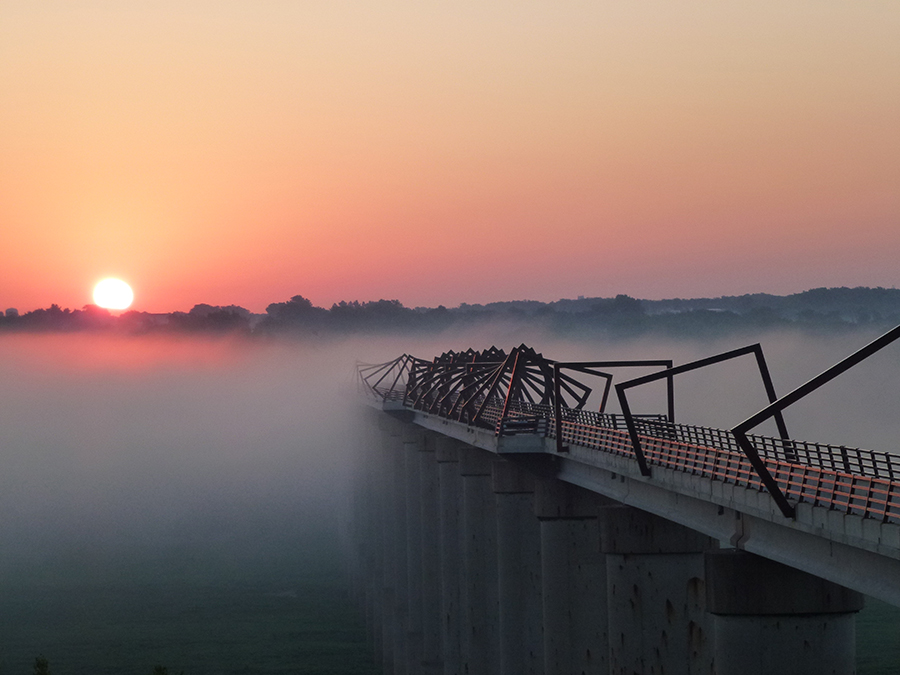
So when will the Great American Rail-Trail be finished? Half the route is already open, with many long stretches able to be enjoyed by the public now. For the remainder, RTC is working collaboratively to identify and close gaps that are in alignment with the trail priorities of the various localities along the route. Throughout the process—which will likely take the next several decades to complete—RTC will not only helm the strategy for the overall vision, but also will provide the roll-up-your sleeves support at the federal, state and local levels to bring expertise and resources for trails within the route.
A first step in that process was RTC’s work in partnership with states and trail groups to analyze and develop the trail’s preferred routing. The subsequent report (available on the Great American Rail-Trail website) was published in May and will serve as a guiding document for completing the Great American Rail-Trail. With that report in hand, RTC is now working with partners to identify projects that would benefit from the organization’s direct involvement and have the potential to serve as catalysts for trail completion.
A top concern of trail planners and managers is how to finance their trail projects. Securing public funding for trails has long been a focus of RTC, and the organization will continue to be a leading advocate for this critical resource.
“Public money is central to how you get public amenities like trails built, and there are federal, state and local roles in that,” said Mills. “At the federal level, there are the existing core programs that RTC helped create in the early 1990s and has helped to sustain, track and nurture to be ongoing sources of funding in every state in the country to build and maintain trails. These include the Transportation Alternatives Program and the Recreational Trails Program.”
In addition, RTC, at times, is able to direct grants to trail projects that may not be eligible for public funds for various reasons—with nearly $1.3 million in grants being applied to communities over the last decade, including for trail projects that have become part of the Great American Rail-Trail.
Earlier this year, RTC provided a $65,000 grant to support the continued development of Nebraska’s Cowboy Recreation and Nature Trail, which will one day span 321 miles and is a key component for taking the Great American Rail-Trail across the state. With sweeping views of the High Plains and pristine prairie, as well as a jaw-dropping bridge over the Niobrara River, the trail offers an exceptional experience for adventurers.

“People love being outside and people love being on bikes, so it’s a great opportunity to showcase all the different communities that we have here in northeast Nebraska,” said Traci Jeffrey, director of the Norfolk Area Visitors Bureau, about this recreational gem for the state.
Building a Nation of Trails
While the communities along the Great American Rail-Trail are as varied as the people within them, they share something in common: a growing passion for trails. It may be for different reasons—as a commuting option for locals or a draw for visitors or a fun recreational amenity for families—but for these reasons and more, trails are considered desirable, even necessary, by residents as an essential ingredient for thriving, healthy communities.
In Missoula, there’s a high value placed on outdoor recreation,” said Gaukler. “We know that about 80 percent of our population says they want more trails and use trails regularly.”
And it’s no wonder. Nestled at the base of mountains, surrounded by wilderness and crossed by the beautiful Clark Fork River, this Montana town has a backdrop that any outdoor enthusiast would want to leap right into. The city’s history as a railroad boom town has also made it ripe for a rail-trail system that gets residents and visitors anywhere they want to go.
Many of the trails within the Great American Rail-Trail footprint have come a long way since their original conception. RTC was founded in 1986, and in the early days of the rail-trail movement, many of these now-valued community assets faced fierce opposition.
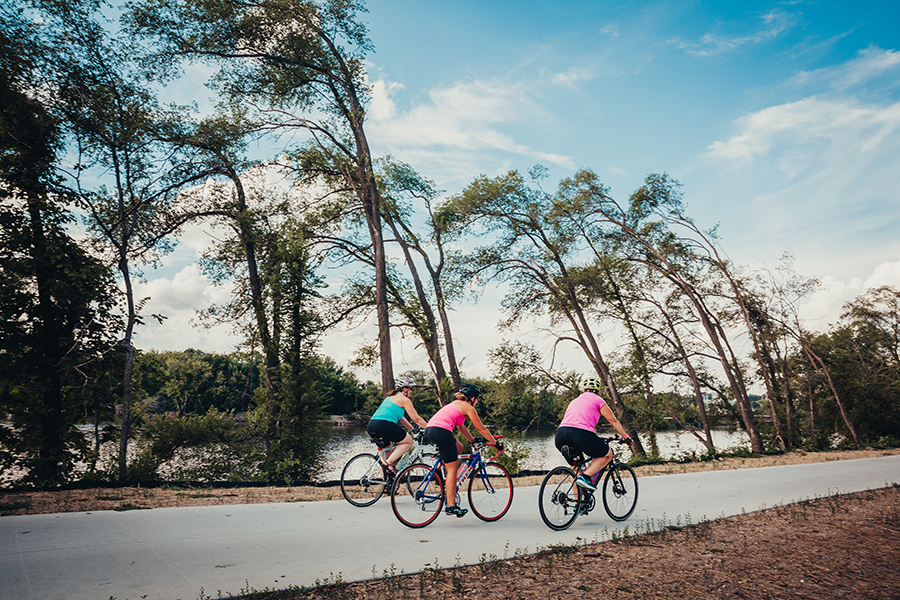
Today, communities are not only clamoring for them to be built, but are championing their trails once developed. This paradigm shift in culture is starkly reflected in the history of the Cedar Valley Nature Trail, one of the first rail-trail conversions in Iowa and a harbinger of the country’s readiness to realize the dream of the Great American Rail-Trail.
“I often hear the stories of the trail bridge burnings and of our former president Mark Ackelson being escorted by police for his safety at a public meeting about the project,” said Andrea Boulton, the trails and greenways director for the Iowa Natural Heritage Foundation, the organization that spearheaded the 52-mile rail-trail. “But today, it’s one of the most popular trails in the state and touted as one of the reasons to come and visit the Cedar Valley area.”
The Great American Rail-Trail has been a dream of RTC for a long time, particularly for its late co-founder David Burwell, who envisioned this cross-country trail as a gift to the nation. The tipping point into action came when analysis revealed that the potential route was more than 50 percent complete. Its viability secured the organization’s long-term commitment to the project.
“This has been an internal drumbeat for the organization for all these years, and our eye was always on it,” said Fowler. “We knew that it was almost inevitable this trail would happen, but it was going to take time before we were ready for it and it was ready for us. Now that time has come!”
Great American Rail-Trail: Long Distance Rides

Ready for adventure? With more than half the Great American Rail-Trail already complete, we’ve compiled a list of five sections that are open now and span 100 miles or more with minimal on-street connections. As surfaces and allowable uses will vary by locality, trail enthusiasts can use TrailLink.com, RTC’s national trail-finder website, as a resource to determine if a trail within the route is suitable for their needs. TrailLink.com includes interactive maps, photos and firsthand reviews of trail experiences. All mileages listed below are approximate.
D.C./MARYLAND: Washington to Cumberland
Length: 184.5 miles
Included trail: Chesapeake & Ohio Canal National Historical Park
OHIO: Fredericksburg to Dayton
Length: 181 miles
Included trails: Ohio to Erie Trail, Creekside Trail, Mad River Trail, Great Miami River Trail, Wolf Creek Trail
NEBRASKA: Norfolk to Valentine
Length: 187 miles
Included trail: Cowboy Recreation and Nature Trail
MONTANA/IDAHO: St. Regis to Plummer
Length: 115 miles
Included trails: Route of the Olympian, NorPac Trail, Trail of the Coeur d’Alenes
WASHINGTON: Beverly to Seattle
Length: 190 miles
Included trails: Palouse to Cascades State Park Trail, Snoqualmie Valley Trail, Preston-Snoqualmie Trail, Issaquah-Preston Trail, East Lake Sammamish Trail, Marymoor Connector Trail, Sammamish River Trail, Burke-Gilman Trail
Special acknowledgements to Kevin Belanger, Amy Kapp, Joe LaCroix and the Great American Rail-Trail Working Group
This article was originally published in the Spring/Summer 2019 issue of Rails to Trails magazine. It has been posted here in an edited format.

Donate
Everyone deserves access to safe ways to walk, bike, and be active outdoors.